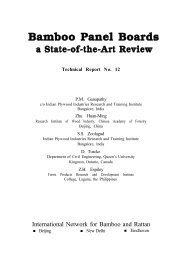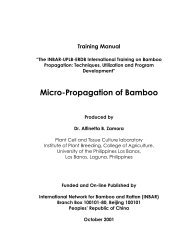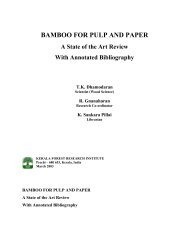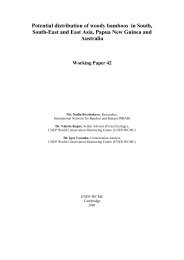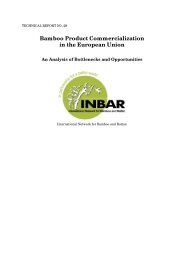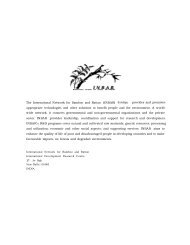The Bamboo and Rattan Sectors in Asia: an Analysis of ... - INBAR
The Bamboo and Rattan Sectors in Asia: an Analysis of ... - INBAR
The Bamboo and Rattan Sectors in Asia: an Analysis of ... - INBAR
You also want an ePaper? Increase the reach of your titles
YUMPU automatically turns print PDFs into web optimized ePapers that Google loves.
Currently, ratt<strong>an</strong> produced <strong>in</strong> Laos is harvested from the wild, without <strong>an</strong>y<br />
m<strong>an</strong>agement <strong>in</strong>put. <strong>The</strong> ma<strong>in</strong> commercial species is known locally as Wai <strong>The</strong>un. It<br />
is a s<strong>in</strong>gle-stem species <strong>of</strong> medium to large diameter, <strong><strong>an</strong>d</strong> belong<strong>in</strong>g to the genus<br />
Calamus. <strong>The</strong>re are also some small-diameter species.<br />
<strong>The</strong>re are no estimates <strong>of</strong> the qu<strong>an</strong>tity <strong>of</strong> ratt<strong>an</strong> available, as a comprehensive<br />
<strong>in</strong>ventory has not been done. However, ratt<strong>an</strong> harvesters report that it is not<br />
evenly distributed <strong><strong>an</strong>d</strong> found sporadically <strong>in</strong> the forest. <strong>Ratt<strong>an</strong></strong> traders report<br />
that it grows <strong>in</strong> patches <strong><strong>an</strong>d</strong> there are only a limited number <strong>of</strong> villages that have<br />
access to commercial qu<strong>an</strong>tities <strong>of</strong> ratt<strong>an</strong>. Un<strong>of</strong>ficial reports by villagers <strong><strong>an</strong>d</strong> some<br />
factory owners <strong>in</strong>dicate that there is plenty <strong>of</strong> ratt<strong>an</strong> <strong>in</strong> the forest, though access<br />
is difficult (the road network <strong>in</strong> the country is very limited). Some traders <strong><strong>an</strong>d</strong><br />
Prov<strong>in</strong>cial Forestry Officers feel that the resources is already be<strong>in</strong>g overexploited<br />
<strong><strong>an</strong>d</strong> that it will not be available <strong>in</strong> adequate qu<strong>an</strong>tities <strong>in</strong> five to seven years.<br />
Cont<strong>in</strong>ued commercial exploitation may depend on improved access to the forest.<br />
However, it does appear that the rate <strong>of</strong> exploitation from accessible areas is<br />
unsusta<strong>in</strong>ably high.<br />
<strong>The</strong> raw material prices have been ris<strong>in</strong>g by about 100 kip/c<strong>an</strong>e/year <strong>in</strong> the last<br />
two or three years (US$1 = 920 kip). One factory reported pay<strong>in</strong>g around 26 kip/c<strong>an</strong>e<br />
<strong>in</strong> 1981, compared with their current cost <strong>of</strong> 800-1 000 kip/c<strong>an</strong>e.<br />
<strong>The</strong> PCS<br />
<strong>The</strong> ma<strong>in</strong> market particip<strong>an</strong>ts are:<br />
● <strong>Ratt<strong>an</strong></strong> collectors<br />
● <strong>Ratt<strong>an</strong></strong> traders<br />
● M<strong>an</strong>ufacturers <strong>of</strong> furniture <strong><strong>an</strong>d</strong> h<strong><strong>an</strong>d</strong>icrafts<br />
● Factory workers<br />
<strong>Ratt<strong>an</strong></strong> collectors are mostly people from villages near the forest. <strong>The</strong>y are<br />
poor, with very limited access to education or health care facilities. Although<br />
most <strong>of</strong> them are shift<strong>in</strong>g cultivators, they depend also on ratt<strong>an</strong> collect<strong>in</strong>g, damar<br />
res<strong>in</strong> tapp<strong>in</strong>g, hunt<strong>in</strong>g <strong><strong>an</strong>d</strong> gather<strong>in</strong>g. Some work as migr<strong>an</strong>t labor to meet their<br />
livelihood needs. Collectors estimate that ratt<strong>an</strong> collect<strong>in</strong>g provides for their<br />
subsistence for about two months <strong>in</strong> a year. Shift<strong>in</strong>g cultivation produces enough<br />
rice for the family for three months, <strong><strong>an</strong>d</strong> the rest is made up from other<br />
activities.<br />
<strong>Ratt<strong>an</strong></strong> collectors have no legal right to the ratt<strong>an</strong> they collect. It is owned by the<br />
state. <strong>The</strong> Prov<strong>in</strong>cial Forest Office assigns a quota to one <strong>of</strong> the ratt<strong>an</strong> comp<strong>an</strong>ies. <strong>The</strong><br />
comp<strong>an</strong>y, <strong>in</strong> turn, engages <strong>an</strong> agent (trader) to org<strong>an</strong>ize the cutt<strong>in</strong>g. Normally the<br />
trader visits the village <strong><strong>an</strong>d</strong> places <strong>an</strong> order for a specified qu<strong>an</strong>tity <strong>of</strong> ratt<strong>an</strong> (as<br />
determ<strong>in</strong>ed by the quota allocated by the Prov<strong>in</strong>cial Forest Department). <strong>The</strong> village<br />
40



